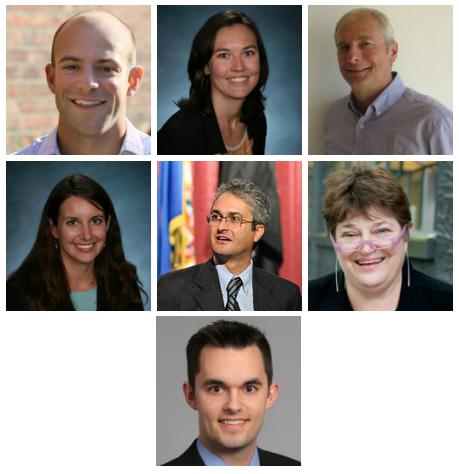Lessons from Auckland with the Runstad Fellows [January 2017 Breakfast Recap]

Happy New Year! The attendees for the January Breakfast Meeting were treated to travel across the Pacific courtesy of the Runstad Fellows with a program entitled Lessons from Auckland.
Outgoing President John Teutsch opened the meeting with thanks to JPC Architects for sponsoring the breakfast. We sincerely appreciate their support. And we sincerely thank John for his leadership.
John then presented awards.
Tim Syverson, Senior Associate Hydrologist at Landau Associates, and Brian Neville, Founder/Owner of Van Zandt Development & Building, were named Volunteers of the Year.
Charlie Hafenbrack, Director of Business Development at GLY, was recognized as the 2016 Board Member of the Year.
Congratulations Tim, Brian and Charlie!
John passed the gavel to Kristin Jensen who is our President for 2017. Kristin let us know about the South Sound Economic Forecast and presented committee updates and new members.
Suzanne Cartwright, Associate Director of the Runstad Center, introduced the topic. We heard from the Runstad team that went to Auckland, which included:
- Giovanni Migliaccio
- Barbara Swift
- Amy Hartman
- Genevieve Hale-Case
- Joe David
- Rick Mohler
- Ben Broesamle
Auckland was chosen because it was comparable to Seattle in terms of climate, population and the challenges that Auckland faces with car traffic. The public right of way in virtually any city is the largest segment of public space, and we saw creative ways Auckland integrated theirs in a way that ties the community together. The first thing Auckland did was to amalgamate the central city with the suburbs, creating one government with one vision: create the world’s most livable city.
With the public right of way, there is a fundamental difference between the way that Seattle and Auckland tackle the issue. Here, the private sector is responsible for design and installation of the adjacent streetscape. In Auckland, the public finances, designs, installs and maintains the streetscape. The interesting turnabout is that the private sector extends that design into their space, making a highly integrated environment.
The Runstad Fellows outlined some case studies and outcomes. Amy spoke of Auckland Transport, the only agency that deals with public transit in Auckland. She spoke of the industrial town of New Lynn where there was a new transit station and residential development. The process encompassed:
- public amenities deployed
- re-purpose existing infrastructure
- attract private development
The outcome? $1 billion of new land value.
Barbara spoke of the Auckland Design Office and a 5.5 kilometer (approx. 3 mile) laneway designed as a safe, walkable loop in the central business district. Outcomes included:
- 243% increase in foot traffic
- 34% decrease in auto traffic
- Zero injuries from vehicle crashes
- 25% increase in consumer spending
- 439% increase in hospitality spending
Ben spoke about the financing aspects of Auckland’s approach. Some of the outcomes outside the laneway are:
- 25% increase in retail sales
- 25% increase in foot traffic
- 4.5% increase in land value
Rick presented the roadmap on how Auckland has accomplished this:
- create the vision for the city
- champion the vision utilizing shared language, storytelling and inspirational documents
- empower the public agencies
- prioritize place
- dissolve silos
- TAKE RISKS!
Kristin closed the meeting after a few questions. This program was inspiring and educational. We thank the Runstad Fellows for their fascinating program!
This article was written by NAIOP Washington State and Programs Committee member Edward Scherer, Account Executive, Avidex Industries, LLC.
